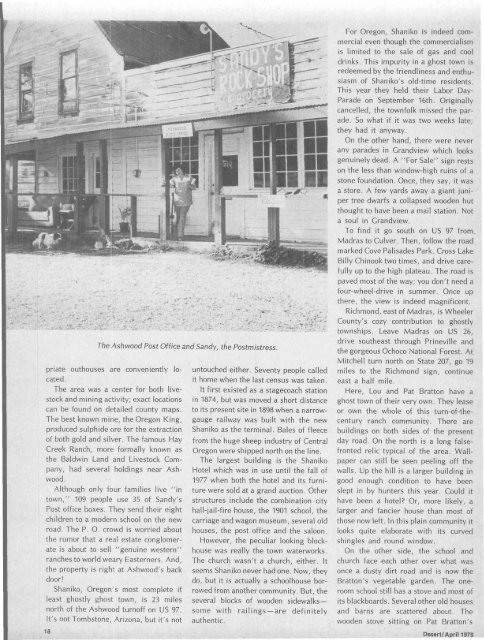Come - Desert Magazine of the Southwest
Come - Desert Magazine of the Southwest
Come - Desert Magazine of the Southwest
Create successful ePaper yourself
Turn your PDF publications into a flip-book with our unique Google optimized e-Paper software.
The Ashwood Post Office and Sandy, <strong>the</strong> Postmistress.<br />
priate outhouses are conveniently located<br />
.<br />
The area was a center for both livestock<br />
and mining activity; exact locations<br />
can be found on detailed county maps.<br />
The best known mine, <strong>the</strong> Oregon King,<br />
produced sulphide ore for <strong>the</strong> extraction<br />
<strong>of</strong> both gold and silver. The famous Hay<br />
Creek Ranch, more formally known as<br />
<strong>the</strong> Baldwin Land and Livestock Company,<br />
had several holdings near Ashwood.<br />
Although only four families live "in<br />
town," 109 people use 35 <strong>of</strong> Sandy's<br />
Post <strong>of</strong>fice boxes. They send <strong>the</strong>ir eight<br />
children to a modern school on <strong>the</strong> new<br />
road. The P. O. crowd is worried about<br />
<strong>the</strong> rumor that a real estate conglomerate<br />
is about to sell "genuine western"<br />
ranches to world weary Easterners. And,<br />
<strong>the</strong> property is right at Ashwood's back<br />
door!<br />
Shaniko, Oregon's most complete if<br />
least ghostly ghost town, is 23 miles<br />
north <strong>of</strong> <strong>the</strong> Ashwood turn<strong>of</strong>f on US 97.<br />
It's not Tombstone, Arizona, but it's not<br />
18<br />
untouched ei<strong>the</strong>r. Seventy people called<br />
it home when <strong>the</strong> last census was taken.<br />
It first existed as a stagecoach station<br />
in 1874, but was moved a short distance<br />
to its present site in 1898 when a narrowgauge<br />
railway was built with <strong>the</strong> new<br />
Shaniko as <strong>the</strong> terminal. Bales <strong>of</strong> fleece<br />
from <strong>the</strong> huge sheep industry <strong>of</strong> Central<br />
Oregon were shipped north on <strong>the</strong> line.<br />
The largest building is <strong>the</strong> Shaniko<br />
Hotel which was in use until <strong>the</strong> fall <strong>of</strong><br />
1977 when both <strong>the</strong> hotel and its furniture<br />
were sold at a grand auction. O<strong>the</strong>r<br />
structures include <strong>the</strong> combination city<br />
hall-jail-fire house, <strong>the</strong> 1901 school, <strong>the</strong><br />
carriage and wagon museum, several old<br />
houses, <strong>the</strong> post <strong>of</strong>fice and <strong>the</strong> saloon.<br />
However, <strong>the</strong> peculiar looking blockhouse<br />
was really <strong>the</strong> town waterworks.<br />
The church wasn't a church, ei<strong>the</strong>r. It<br />
seems Shaniko never had one. Now, <strong>the</strong>y<br />
do, but it is actually a schoolhouse borrowed<br />
from ano<strong>the</strong>r community. But, <strong>the</strong><br />
several blocks <strong>of</strong> wooden sidewalkssome<br />
with railings —are definitely<br />
au<strong>the</strong>ntic.<br />
For Oregon, Shaniko is indeed commercial<br />
even though <strong>the</strong> commercialism<br />
is limited to <strong>the</strong> sale <strong>of</strong> gas and cool<br />
drinks. This impurity in a ghost town is<br />
redeemed by <strong>the</strong> friendliness and enthusiasm<br />
<strong>of</strong> Shaniko's old-time residents.<br />
This year <strong>the</strong>y held <strong>the</strong>ir Labor Day-<br />
Parade on September 16th. Originally<br />
cancelled, <strong>the</strong> townfolk missed <strong>the</strong> parade.<br />
So what if it was two weeks late;<br />
<strong>the</strong>y had it anyway.<br />
On <strong>the</strong> o<strong>the</strong>r hand, <strong>the</strong>re were never<br />
any parades in Crandview which looks<br />
genuinely dead. A "For Sale" sign rests<br />
on <strong>the</strong> less than window-high ruins <strong>of</strong> a<br />
stone foundation. Once, <strong>the</strong>y say, it was<br />
a store. A few yards away a giant juniper<br />
tree dwarfs a collapsed wooden hut<br />
thought to have been a mail station. Not<br />
a soul in Crandview.<br />
To find it go south on US 97 from,<br />
Madras to Culver. Then, follow <strong>the</strong> road<br />
marked Cove Palisades Park. Cross Lake<br />
Billy Chinook two times, and drive carefully<br />
up to <strong>the</strong> high plateau. The road is<br />
paved most <strong>of</strong> <strong>the</strong> way; you don't need a<br />
four-wheel-drive in summer. Once up<br />
<strong>the</strong>re, <strong>the</strong> view is indeed magnificent.<br />
Richmond, east <strong>of</strong> Madras, is Wheeler<br />
County's cozy contribution to ghostly<br />
townships. Leave Madras on US 26,<br />
drive sou<strong>the</strong>ast through Prineville and<br />
<strong>the</strong> gorgeous Ochoco National Forest. At<br />
Mitchell turn north on State 207, go 19<br />
miles to <strong>the</strong> Richmond sign, continue<br />
east a half mile.<br />
Here, Lou and Pat Bratton have a<br />
ghost town <strong>of</strong> <strong>the</strong>ir very own. They lease<br />
or own <strong>the</strong> whole <strong>of</strong> this turn-<strong>of</strong>-<strong>the</strong>century<br />
ranch community. There are<br />
buildings on both sides <strong>of</strong> <strong>the</strong> present<br />
day road. On <strong>the</strong> north is a long falsefronted<br />
relic typical <strong>of</strong> <strong>the</strong> area. Wallpaper<br />
can still be seen peeling <strong>of</strong>f <strong>the</strong><br />
walls. Up <strong>the</strong> hill is a larger building in<br />
good enough condition to have been<br />
slept in by hunters this year. Could it<br />
have been a hotel? Or, more likely, a<br />
larger and fancier house than most <strong>of</strong><br />
those now left. In this plain community it<br />
looks quite elaborate with its curved<br />
shingles and round window.<br />
On <strong>the</strong> o<strong>the</strong>r side, <strong>the</strong> school and<br />
church face each o<strong>the</strong>r over what was<br />
once a dusty dirt road and is now <strong>the</strong><br />
Bratton's vegetable garden. The oneroom<br />
school still has a stove and most <strong>of</strong><br />
its blackboards. Several o<strong>the</strong>r old houses<br />
and barns are scattered about. The<br />
wooden stove sitting on Pat Bratton's<br />
<strong>Desert</strong>/April 1979
















